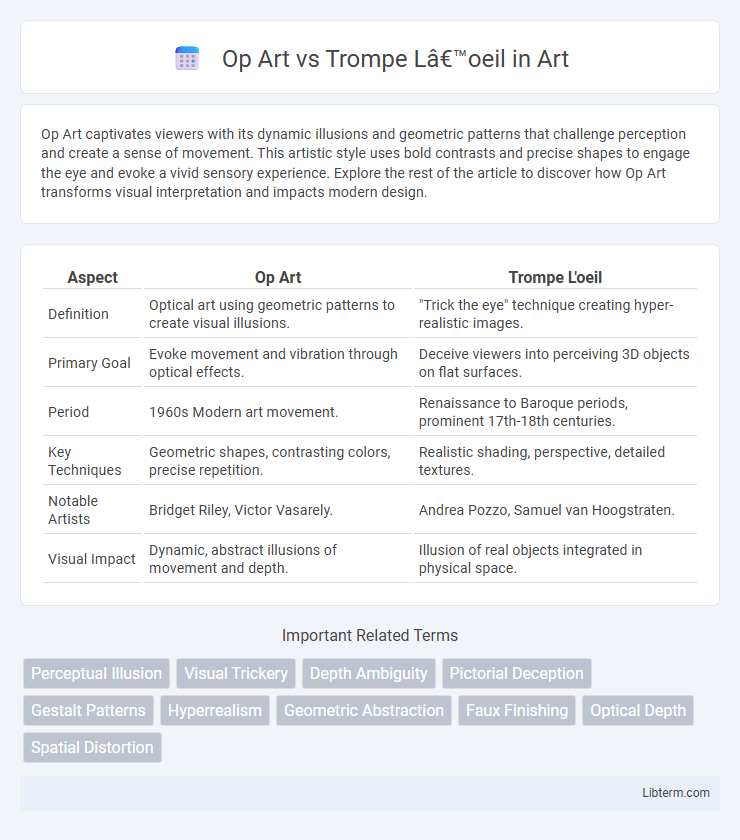Op Art captivates viewers with its dynamic illusions and geometric patterns that challenge perception and create a sense of movement. This artistic style uses bold contrasts and precise shapes to engage the eye and evoke a vivid sensory experience. Explore the rest of the article to discover how Op Art transforms visual interpretation and impacts modern design.
Table of Comparison
| Aspect | Op Art | Trompe L'oeil |
|---|---|---|
| Definition | Optical art using geometric patterns to create visual illusions. | "Trick the eye" technique creating hyper-realistic images. |
| Primary Goal | Evoke movement and vibration through optical effects. | Deceive viewers into perceiving 3D objects on flat surfaces. |
| Period | 1960s Modern art movement. | Renaissance to Baroque periods, prominent 17th-18th centuries. |
| Key Techniques | Geometric shapes, contrasting colors, precise repetition. | Realistic shading, perspective, detailed textures. |
| Notable Artists | Bridget Riley, Victor Vasarely. | Andrea Pozzo, Samuel van Hoogstraten. |
| Visual Impact | Dynamic, abstract illusions of movement and depth. | Illusion of real objects integrated in physical space. |
Introduction to Op Art and Trompe L’oeil
Op Art, short for Optical Art, emerged in the 1960s, focusing on creating visual effects that exploit human perception through geometric patterns and contrasting colors, often resulting in illusions of movement or vibration. Trompe L'oeil, a classical painting technique dating back to Ancient Greece, aims to deceive the eye by rendering objects with such accuracy and detail that they appear three-dimensional and physically present on flat surfaces. Both art forms manipulate perception but Op Art emphasizes optical illusions via abstract forms, whereas Trompe L'oeil relies on realistic imagery to trick the viewer's gaze.
Historical Origins and Evolution
Op Art originated in the 1960s, emphasizing optical illusions and geometric patterns to create visual movement, rooted in the Bauhaus and Constructivist movements of the early 20th century. Trompe L'oeil dates back to ancient Greece and Rome, evolving through the Renaissance as a technique that uses realistic imagery to deceive the eye into perceiving three-dimensional space on flat surfaces. Both styles reflect distinct historical contexts; Op Art aligns with modern explorations of perception and technology, while Trompe L'oeil emphasizes classical mastery of perspective and illusion.
Defining Characteristics of Op Art
Op Art is defined by its use of precise geometric shapes, high-contrast colors, and optical illusions that create a sense of movement or vibration, engaging viewers' visual perception. The key characteristics include repetitive patterns, stark black-and-white contrasts, and dynamic effects that manipulate depth and figure-ground relationships. Unlike Trompe L'oeil's hyper-realistic techniques intended to deceive the eye with lifelike imagery, Op Art emphasizes abstract visual effects that challenge the observer's spatial awareness.
Key Features of Trompe L’oeil
Trompe L'oeil is characterized by its hyper-realistic imagery designed to create the optical illusion that depicted objects exist in three dimensions. Key features include precise perspective, meticulous attention to light and shadow, and detailed textures that deceive the viewer's eye into perceiving painted elements as tangible reality. Unlike Op Art's focus on abstract patterns and optical vibrations, Trompe L'oeil emphasizes lifelike representation and spatial depth.
Techniques Used in Op Art
Op Art techniques emphasize precise geometric patterns, optical illusions, and contrasting colors to create the sensation of movement and vibration. Artists employ repetitive shapes, lines, and grids combined with high-contrast black-and-white or vibrant color schemes to manipulate visual perception. This method contrasts with Trompe L'oeil, which uses realistic shading, perspective, and fine detail to trick the eye into perceiving painted objects as three-dimensional.
Techniques Used in Trompe L’oeil
Trompe L'oeil techniques rely heavily on precise perspective, meticulous shading, and detailed texture to create the illusion of three-dimensionality on flat surfaces. Artists use chiaroscuro to enhance depth and manipulate light and shadow, making painted objects appear real enough to deceive the eye. The technique often incorporates architectural elements and everyday objects rendered with hyper-realistic detail to intensify the visual trickery inherent in Trompe L'oeil art.
Major Artists in Op Art and Their Contributions
Major artists in Op Art, such as Bridget Riley and Victor Vasarely, revolutionized visual perception by using geometric patterns and optical illusions to create movement and depth on flat surfaces. Bridget Riley's work employs precise black-and-white designs that challenge visual stability, while Victor Vasarely's vibrant, colorful compositions laid the foundational principles of Op Art as a movement. Their contributions significantly advanced the exploration of visual dynamics and influenced contemporary graphic design and art worldwide.
Renowned Trompe L’oeil Artists
Renowned Trompe L'oeil artists like Bill Fink and John Pugh masterfully create hyper-realistic illusions that deceive the eye by rendering three-dimensional scenes on flat surfaces, contrasting with Op Art's focus on abstract, geometric patterns that evoke optical movement. Trompe L'oeil relies heavily on meticulous detail and perspective to trick viewers into perceiving painted objects as tangible, while Op Art emphasizes dynamic visual effects through color and shape interactions. The legacy of Trompe L'oeil artists significantly influences public murals and architectural artworks, showcasing a unique blend of realism and illusionism.
Visual Effects and Perceptual Impact
Op Art exploits optical illusions through precise patterns and contrasting colors to create dynamic movement and vibration, challenging viewers' depth perception and spatial awareness. Trompe L'oeil utilizes meticulous realism and perspective to deceive the eye, producing the illusion of three-dimensional objects or scenes on flat surfaces. The visual effects in Op Art provoke sensory engagement and cognitive dissonance, while Trompe L'oeil creates immersive realism that blurs boundaries between artwork and reality.
Contemporary Relevance and Influence
Op Art's contemporary relevance thrives in digital media and design, where its optical illusions inspire immersive visual experiences and interactive art installations. Trompe L'oeil maintains influence in modern architecture and street art, employing hyperrealistic techniques to blur boundaries between reality and art, enhancing spatial perception and aesthetic engagement. Both art forms continue shaping contemporary visual culture by challenging viewers' perception and blending artistic innovation with everyday environments.
Op Art Infographic

 libterm.com
libterm.com